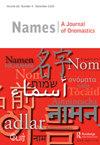韩国人名的单音节情感语用学
IF 0.6
3区 文学
0 LANGUAGE & LINGUISTICS
引用次数: 0
摘要
在本文中,我研究了在没有主音标记的情况下使用的韩语单音节词的形成和语音变化。朝鲜语单音节词缀是截断和融合的结果。研究表明,保留第二个音节的倾向在截断形式中更为明显。最常见的合并类型是“第一个音节的开头+第二个音节的押韵”。这显示了对称的基础锚定模板,其中模板的边锚定到基础的左右边。朝鲜语单音节元音所经历的语音变化包括阻音的张化、平擦音或塞擦音的停止、鼻平化、鼻插入、元音圆化、元音简化和元音前腭滑音插入。辅音交替似乎比声乐交替更受欢迎。所有的分段交替都出现在Aegyo语音寄存器中。本文章由计算机程序翻译,如有差异,请以英文原文为准。
Monosyllabic Affective Hypocoristics of Korean Names
In this paper, I investigate the formation and phonological alternations of Korean monosyllabic hypocoristics that are used without a vocative marker. Korean monosyllabic hypocoristics are the result of truncation and merging. The study showed that the inclination to keep the second syllable is more pronounced in truncated forms. The most common type of merging is ‘onset of 1st syllable + rhyme of 2nd syllable’. This illustrates the symmetrical base anchoring template, in which the template’s edges are anchored to the base’s right and left edges. The phonological alternations that Korean monosyllabic hypocoristics go through include tensification of obstruents, stopping of plain fricative or affricate, nasal velarization, nasal insertion, vowel rounding, vowel simplification, and palatal glide insertion before a vowel. Consonantal alternations over vocalic alternations seem to be preferred. All of the segmental alternations are present in the Aegyo speech register.
求助全文
通过发布文献求助,成功后即可免费获取论文全文。
去求助
来源期刊

Names-A Journal of Onomastics
Multiple-
CiteScore
1.30
自引率
50.00%
发文量
23
期刊介绍:
Names, the journal of the American Name Society, is one of the world"s leading journals in the study of onomastics. Since the first issue in 1952, this quarterly journal has published hundreds of articles, reviews, and notes, seeking to find out what really is in a name, and to investigate cultural insights, settlement history, and linguistic characteristics revealed in names. Individuals subscribing to Names automatically become members of the American Name Society and receive the journal as part of their membership.
 求助内容:
求助内容: 应助结果提醒方式:
应助结果提醒方式:


